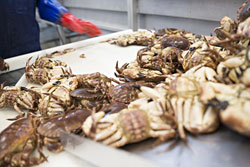
Seafood producer Hitramat is Norway’s largest producer of crab and produces a wide selection of different crab products. The company purchases crabs from 250 fishermen who fish waters from Måløy to Bodø. Hitramat sells a proportion of the crabs whole. The best crabs with the highest meat content are sorted out for this production.
Manual sorting is an uncertain and uneconomical method
However, the company had problems sorting out the crabs with the most meat content. Through manual sorting, high level of water content was often assessed as high level of meat content. As a result, the company risked dissatisfied customers when the opened the crab and did not find as much crab meat as they expected. Manual sorting also led to a large margin of error. Only one crab in five was assessed as good enough after the boiling process based on insufficient meat content.
In connection with the CrustaSea project Hitramat was part of, Senior Scientist Jens Petter Wold at the food research institute Nofima was contacted and asked to assist with technology. Wold adapted a scanner that had previously been developed for rapid assessment of water content in clipfish. This scanner transilluminates the crab, and based on the light that is absorbed it is possible to calculate the amount of meat in the crab. This technology makes it easier to find the best and meatiest crabs and ensures the consumer will buy a product that meets their satisfaction.
“With manual sorting of the crabs to be sold whole, about 20 per cent were approved after boiling. Now with new technology in place, around 50 per cent of the crabs are sold whole,” says Kolbjørn Ulvan, factory manager at Hitramat. “The economic scopes concerning the line production of whole crabs have increased drastically and the company is hoping for another lift soon.”
“Our long-term goal is to sell 80 per cent of the crabs whole using this scanner, which we could describe as a success,” says the factory manager.
Electronic stunning
While the scanner was being tested at Hitramat, a new problem emerged. When the crabs were placed on the production line to go under the scanner, they kept moving, which made it difficult to get accurate measurements of the content.
Another scientist from Nofima then appeared with another new technology idea! Scientist Bjørn Roth carried out laboratory experiments at Nofima in Stavanger on electronic stunning of crabs. In this method, the crabs are sent into a machine, which is actually a commercial fish stunner that has been adapted from crabs. The crabs are subjected to a series of electronic shocks so they rapidly lose consciousness. The crabs then enter a tank of ice-water that gives the crab a thermal shock and kills the unconscious shellfish. The traditional method for killing the crabs is manual and would have been too labour-intensive before scanning.
Using electronic stunning and thermal shock, the crabs will be dead before they end up under the scanner. This production change increases both efficiency and profitability at the company. This new method of killing the crabs also complies with the new requirements laid down by the Norwegian Food Safety Authority, which state that a crab must be killed in one second.
“The technology we have achieved is very good and we believe the product we are producing for our customers has improved, so we are very satisfied,” says Kolbjørn Ulvan.
The project is financed by Hitramat, the Research Council of Norway, Seaside, Odenberg (formerly QVision) owned by TOMRA, Møreforskning, Nofima, SkatteFUNN, the Norwegian Seafood Association (NSL), Teknologisk Institutt and DataDesign.







